|
Mayhem
1520mmEPP
Crash Resistant Sports Aerobatic Slope Soarer
Designed
by Stan Yeo
Produced
by PHOENIX MODEL PRODUCTS
Introduction
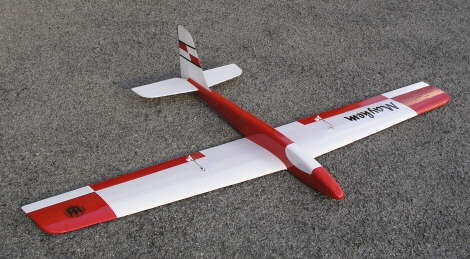
The Mayhem
is a stylish, high performance, crash resistant, sports aerobatic slope
soarer designed to meet the ever increasing demands of the discerning
everyday sports flyer. It will do all manoeuvres expected of a sports
aerobatic sloper i.e. sustained inverted flight, loops, rolls and bunts
etc., It will also do a 'bun-roll' (an outside loop with a roll at the
bottom) a manoeuvre few aerobatic slopers are capable of. Despite this
the Mayhem is a graceful docile model to fly and will thermal turn with
the best of them when the need arises.
In its basic
form the Mayhem can be flown with any 4 channel transmitter but to achieve
the best from the model a computerised transmitter is recommended so that
the ailerons can be used as flaps (flapperons) and the flaps can then
be coupled with the elevator to improve the 'looping' performance. The
flaps can also be used assist landings in confined spaces.
Please do
not attempt to use plastic geared servos - they do not last long in EPP
models! Our EPP models are a little more complex to build than most of
their contemporaries this is more than compensated for in their performance.
Building time however is still relatively short when compared to that
of an equivalent wood foam model.
R/C
Equipment
The R/C Equipment
used in the prototypes consisted of four metal gear micro servos (HS81MG/
85MG) a 2/3 AF size Rx flat Nicad pack plus a JR R700 / Hitec Slimline
/ Webra 6 / Futaba 147F Rx, two servo extension leads and a switch harness.
All the items are available from PMP at competitive prices.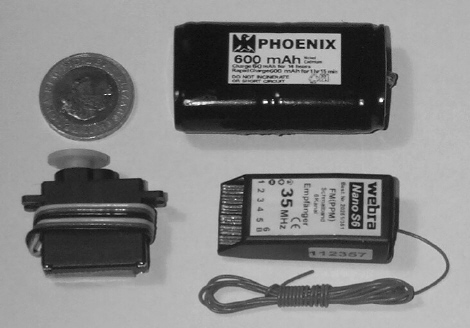
Tools
/ Materials Required
The only
tools required are a modelling knife with spare blades, 180 grade Wet
& Dry sanding block, a can of spray impact adhesive such as Stikatak,
some runny super glue (please observe safety precautions on packets!),
12 minute epoxy a soldering iron and a long straight.
Building
the Fuselage
- Lightly sand the fuselage sides, top and bottom with 180 grade
wet and dry to remove the 'release' agent. Remove dust with a small
brush or vacuum cleaner.
- Mark position of 4.5mm distance pieces (5 off) to fuselage sides
ensuring you have a left and right side!
- Superglue 4.5mm sq. strip and triangular nose strips to fuselage
sides.

- Superglue wing seats in position.
- Superglue nose former and the other four 4.5mm distance pieces
to one fuselage side ensuring they are all perpendicular (use set
square). Check dowel former can be slid in position.

- Join fuselage sides together over plan checking that the fuselage
sides are correctly aligned using set square.
- Cut 1.5mm ply fuselage top to length and superglue in position.

- Repeat Step 8 above for fuselage bottom allowing for wing dowel
plate.
- Superglue triangular strip to outside of fuselage to extend tailplane
seat.
- BUILD WING
- Construct Wing Nut block assembly as per plan. Slide into position
and hold in place with scrap foam rubber. Slide into position the
6mm ply Wing Dowel plate.
- Fit the wing to the fuselage and mark position of wing dowel hole
on dowel plate. Tip - wet end of dowel tube with felt tip pen to leave
impression on dowel plate. Ensure dowel hole is in middle of dowel
plate and dill dowel hole. Do not allow centre of dowel hole to drift
towards bottom of fuselage as this will prevent wing fitting snugly
in wing seat.
- Superglue dowel former in position. If necessary, slide former
'in & out' as appropriate to compensate for any inaccuracies in drilling
dowel hole.
- Fit triangular strip to front of dowel former (see plan).
- Fit wing to fuselage and locate position of wing nut assembly.
- Glue nut assembly in position.
- Glue EPP sheets to fuselage sides using spray adhesive (spray both
surfaces). Allow a couple of minutes for solvent in adhesive to evaporate
before fitting EPP to fuselage. Extend the EPP past the nose former
by at least 12mm to form nose weight cavity (see plan). Due to the
length of the EPP blocks this will leave a gap at the tail. Fill this
gap with an off-cut. Also remember this is a ONE shot operation!
- Trim the EPP to shape of fuselage using White Spirit to lubricate
knife. The best tool for this operation is one made from a broken
piece of hacksaw blade approximately a 75mm long. Grind the teeth
off without getting the blade so hot that it loses its temper and
goes soft. Sharpen blade on a whetstone or oilstone so that you could
almost shave with it! The advantage of this blade over commercial
blades is that it is flexible allowing the 'handle' to be bent out
of the way when cutting the EPP to achieve an acute cutting angle.
- Construct Elevator and Rudder hinges by removing 1.5mm wide strip
of Correx on one side of tailplane / Fin as per the plan.
- If applicable fit the optional 3mm dia. carbon rods into fin. Wrap
carbon rods in masking tape to produce a snug fit (see plan).
- Superglue 9mm balsa strips to base of fin after shaping. Check
fin sits vertically on a flat surface.
- Mark centreline on top of tailplane (hinge cut-out underneath)
ensuring that it is at right angles to tailplane axis.
- Superglue Fin to tailplane ensuring it is square and vertical.
If the Fin is not vertical slice along the balsa strip on the side
the Fin is leaning towards and insert a piece of thin cardboard. Superglue
in place.
- Mount the wing on the fuselage. Check that it is square to the
fuselage. Check tailplane seat is clean and flat.
- Epoxy tailplane assembly to fuselage. Check the tailplane is parallel
to the wing and the Fin is in line with the axis of the fuselage and
perpendicular. The epoxy an be 'bulked' out using an appropriate filler
such micro balloons. This will assist in 'seating' the tailplane.
- Fit rudder and elevator pushrods. Anchor to fuselage on opposite
side to exit at mid-point and end. Throughout this operation the pushrod
must remain in the conduit and checked regularly for free movement.
- Glue plastic aerial tube / Fin fairing to Fin leading edge using
impact adhesive such as Evo-Stick. Tape in position until glue is
set (24hrs).
- Glue 10mm thick EPP to fuselage top again extending EPP forward
of the nose former and stopping at Fin base.
- Glue EPP sheet to fuselage bottom at nose. Again extending beyond
nose former.
- Glue EPP sheet to rear of Fuselage and trim to shape.
- Glue approximately 150grams of roofing lead to front of nose former
in cavity formed by EPP sides. This is typically 2mm thick and equates
to 5 layers of lead. Flatten lead before fitting. Roofing lead is
available from the scrap yard at approximately £1.00 a kilo.
- Trim EPP in front of nose weight to provide flat surface on which
to glue EPP nose-block.
- Fit nose block and shape fuselage i.e. round corners using sharp
knife and 180 grade wet & Dry (use dry!).
- Fit Rudder and Elevator servos to balsa blocks but do not glue
in place (see plan). Bias servos away from fuselage side that connects
to the pushrod to get maximum control movement from servo. Position
servo assembly in fuselage and superglue in place.
- Spray fuselage with Impact Adhesive and cover fuselage using CW tape.
Overlap each strip by 6 - 10 mm or 1/4 to 3/8 inch. If top covering
is a polyester iron film then the CW tape can be laid diagonally (see
plan). Use Film Iron to remove wrinkles around compound curves. Temperature
required for this operation is fairly critical. Do not dwell in one
spot too long to avoid damaging the foam. Use white spirit to lubricate
cutting knife. 36. After covering fuselage connect up control surfaces.
Check all transmitter trims are in neutral. If using a computerised
transmitter use the sub-trim facility to zero the servo output arms
and lock the control surfaces in neutral before cutting pushrods to
length.
- Excess impact adhesive can be removed using white spirit.
Building
the Wings.
- Lightly sand wing surfaces and remove dust as before. Trim and
sand spar slots to accommodate mainspars. This is best achieved using
very sharp knife and a spar length straight edge (tip - stick 180
grade we & Dry to under surface to prevent slippage) plus a short
length of 100mm thick ply fitted with Wet & Dry along the edge to
final sand the spar slot. Unfortunately CNC cutting tapered wings
with spar slots results in a tapered spar slot due to the way CNC
cutters work.
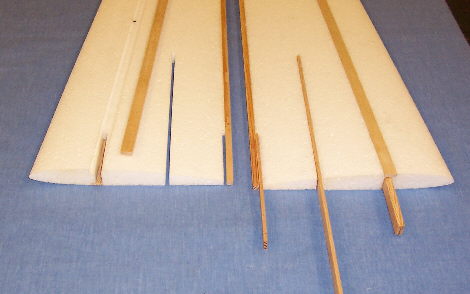
- Remove waste from wing bracing slots.
- Fit top wing spars using Epoxy keeping spar bracing slots free
of Epoxy. Place packing tape along spars, place wing on a flat surface.
Hold flat with weights until epoxy set.
- Trim spars to length.
- Fit 6mm sq trailing edges using epoxy again keeping bracing slots
free of epoxy. Use masking tape to hold spar in position whilst Epoxy
sets. Trim to length.
- Dry fit bottom mainspars and trim to size.
- Dry assemble wing and check wing roots 'mate'. Adjust as necessary.
- With wing upside down fit wing brace and bottom wing spars.
- Fit rear spar brace and trim to size when epoxy set.
- Fit rear wing brace using epoxy.
- Manufacture Elevons and wing centre by laminating 0.8mm ply and
balsa trailing using spray impact adhesive. Place under weight until
adhesive has properly set.
- Glue centre section to wing observing wing reflex (apparent up
elevator). Refer to wing seat on fuselage.
- Fit 0.8mm ply ends to centre section and one end of each Elevon.
- Sand wing tips to shape and trim Elevons to size. Sand to shape.
- Epoxy balsa block in position at wing join. Bottom of block should
be flush with bottom surface of wing.
- Trim top surface of block to shape of top surface of wing. DO NOT
trim bottom of block.
- Locate centre of balsa block and centre of wing leading edge. Drill
hole for 5mm diameter brass tube the houses 4.5mm diameter hardwood
wing locating dowel.
- Epoxy wing dowel tube in place. Mark centre of tube hole on 6mm
ply dowel locater in fuselage. Use felt tip pen to assist in this.
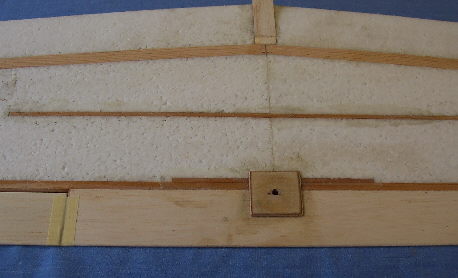
- Drill hole for M5 wing bolt in wing and ply bolt plate. Do not
drill through rear spar!
- Fit 1.5mm ply wing bolt reinforcing plate using superglue.
- Mark position of wing servos (plan drawing is NOT full size. Position
of servo is dependant on servo lead length. Allow 30mm from end of
plug to servo lead exit from wing for connecting to receiver extension
lead when fitting wing. Note servo arms both point outboard of wing.
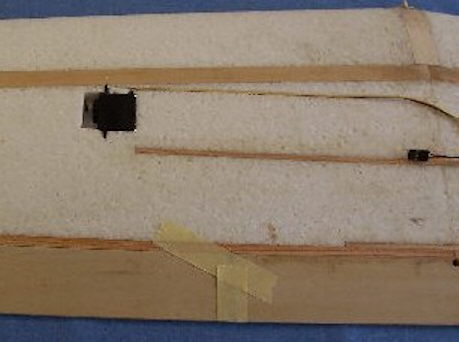
- Cut rectangular hole for servo in wing ignoring servo mounting
lugs.
- Cut slot in EPP for servo lugs and fit servo so that it is flush
with top of wing. Note gap between top of servo and bottom of wing.
From block of EPP removed for servo from wing slice off the required
amount and fit in this void.
- Remove wing servos for covering.
- Shape wing tips.
- Spray wing with spray adhesive and cover wing with CW tape. For
torsional rigidity cover the wing with CW tape diagonally. There is
no need to wrap around rear spar but do overlap by 5 - 10mm at leading
edge. For smooth finish do not overlap CW Tape. Use film iron to remove
wrinkles at tips.
- After covering fit aileron servos. Cut vertical slot in wing to
hide servo leads.
- Cover wing with either coloured vinyl tape or an iron on polyester
film (NOT polypropylene it stretches!). This is necessary for two
reasons, one to decorate the model and secondly to protect the CW
Tape from the effects of ultra violet light. If film covering roughen
surface of CW Tape a lightly spray with impact adhesive.
- Cover Elevons in an iron on film in suitable colour. DO NOT use
CW or vinyl tape.
- Hinge Ailerons using Sellotape diamond as shown on the plan.
- Fit control linkages and adjust to obtain required throws (see
flying section). Before manufacturing control pushrods centre the
servos first ensuring the aileron trims are in neutral. If applicable
use sub-trim facility for final adjustment and tape ailerons in neutral
using masking tape. Tip - place masking tape under pushrod when soldering
to avoid solder damaging covering should it drip.
- DO NOT replace the plastic mini-snaplinks with metal devises. In
the event of a mishap the plastic snaplinks will break thereby reducing
the risk of damage to the elevon servos.
Flying
To achieve
the design performance of any model care must be taken in
setting up the controls and balancing the model, both laterally (wing
tip to wing tip) and longitudinally (nose to tail). The Mayhem is no exception.
Control movements must be symmetrical i.e. the same both sides.
- Set the controls to give the following movements for initial flights:
- Ailerons +/- 22mm
- Elevator
+/- 12mm Rudder
+/- 45 degrees
- Flapperons
6mm UP Down Elevator 5mm DOWN Up Elevator
- Balance
Point 100mm +/- 3mm from LE at back of dowel former.
-
Adjust balance to within recommended limits. Prototypes required a
small amount of additional nose-weight to that fitted in the nose.
Do not worry about the amount of lead carried in the nose. With slope
soarers there is an optimum weight for a model. If the model is too
light or too heavy then the performance will suffer. The only energy
a model has to perform aerobatics is that due to its speed and weight.
If too light then it will run out of 'puff' before it has completed
the manoeuvre. Too heavy and the excess drag created as a result of
the extra work the wing has to do will either result in a tip stall
or a failure to complete the manoeuvre for a similar reason to that
above.
-
Remember all aerobatic manoeuvres require energy to perform them.
If the model has insufficient speed it will fall out of the manoeuvre
or perform it half-heartedly. Vertical or near vertical dives are
not an efficient way to build up speed, 20- 30 degree dives are much
more efficient. Avoid sudden control inputs unless you intentionally
want to carry out 'flick' manoeuvres. In most cases all they do is
scrub off speed and lose height. Try to fly smoothly with the minimum
of control input as not only do the manoeuvres look better but you
will be able to perform more of them before having to regain height.
Try stringing manoeuvres together paying particular attention to positioning.
Be creative and set yourself targets for each flying session.
-
If the lift is very good or you are having difficulty penetrating
into wind try ballasting the model. This will increase penetration
and help to model maintain speed through manoeuvres. Note when adding
ballast take care not to disturb the balance point. We have found
the optimum ballast to be about 200 grams. Over-ballasting any model
as previously mentioned leads to a degradation in performance often
accompanied by tendency to tip stall.
-
The suggested control settings are a starting point and can be adjusted
to suit your personal tastes. An indication that the balance point
is about right can be gauged by the amount of down elevator required
for smooth inverted flight and how the model naturally recovers from
a dive with the controls (sticks) in neutral.
-
If you are using a computerised transmitter program in positive Exponential
on the Aileron and Elevator controls. This will 'soften' the controls
around the neutral position and facilitate smoother flying particularly
on the elevator control.
-
The Mayhem will take a lot of punishment. It is excellent for building
confidence and will add another dimension to your flying but please
remember if you take a big enough hammer to anything it will break.
The CW tape used for covering also degrades in ultra-violet light
so store the model in a relatively cool place away from direct sunlight.
-
When landing the Mayhem treat it like you would a conventional wood
/ foam model or moulded machine and fly a conventional landing circuit
(see Prepare to Land article on our website). Using the typical combat
style flying wing landing technique is not only high risk due to the
Mayhem's increased flying speed but does nothing to improve your landing
technique in preparation for the day when you fly a model that breaks
more easily when it hits the ground.
-
The modified MH42 wing section is very efficient and performs well
in light lift so with good ballast selection Mayhem will cope with
almost any wind / lift conditions you are inclined to fly in.
-
Finally should you require further assistance or advice please contact
us either by letter, telephone, email or visit our website (http://www.phoenixmp.com)
where you will find useful information on sloping etc.
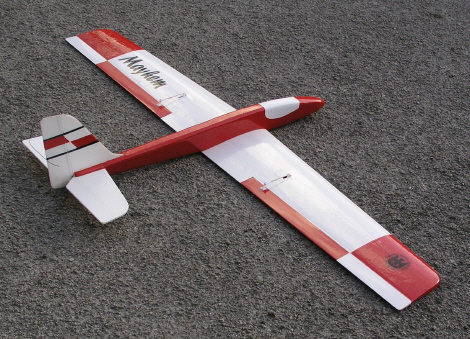
Happy flying
and safe landings
Stan Yeo
Mayhem
050222
|